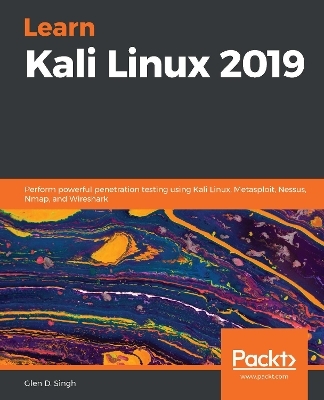
Learn Kali Linux 2019
Packt Publishing Limited (Verlag)
978-1-78961-180-9 (ISBN)
Explore the latest ethical hacking tools and techniques in Kali Linux 2019 to perform penetration testing from scratch
Key Features
Get up and running with Kali Linux 2019.2
Gain comprehensive insights into security concepts such as social engineering, wireless network exploitation, and web application attacks
Learn to use Linux commands in the way ethical hackers do to gain control of your environment
Book DescriptionThe current rise in hacking and security breaches makes it more important than ever to effectively pentest your environment, ensuring endpoint protection. This book will take you through the latest version of Kali Linux and help you use various tools and techniques to efficiently deal with crucial security aspects.
Through real-world examples, you’ll understand how to set up a lab and later explore core penetration testing concepts. Throughout the course of this book, you’ll get up to speed with gathering sensitive information and even discover different vulnerability assessment tools bundled in Kali Linux 2019. In later chapters, you’ll gain insights into concepts such as social engineering, attacking wireless networks, exploitation of web applications and remote access connections to further build on your pentesting skills. You’ll also focus on techniques such as bypassing controls, attacking the end user and maintaining persistence access through social media. Finally, this pentesting book covers best practices for performing complex penetration testing techniques in a highly secured environment.
By the end of this book, you’ll be able to use Kali Linux to detect vulnerabilities and secure your system by applying penetration testing techniques of varying complexity.
What you will learn
Explore the fundamentals of ethical hacking
Learn how to install and configure Kali Linux
Get up to speed with performing wireless network pentesting
Gain insights into passive and active information gathering
Understand web application pentesting
Decode WEP, WPA, and WPA2 encryptions using a variety of methods, such as the fake authentication attack, the ARP request replay attack, and the dictionary attack
Who this book is forIf you are an IT security professional or a security consultant who wants to get started with penetration testing using Kali Linux 2019.2, then this book is for you. The book will also help if you’re simply looking to learn more about ethical hacking and various security breaches. Although prior knowledge of Kali Linux is not necessary, some understanding of cybersecurity will be useful.
Glen D. Singh, CEH, CHFI, 3xCCNA (cyber ops, security, and routing and switching) is a cyber security instructor, author, and consultant. He specializes in penetration testing, digital forensics, network security, and enterprise networking. He enjoys teaching and mentoring students, writing books, and participating in a range of outdoor activities. As an aspiring game-changer, Glen is passionate about developing cyber security awareness in his homeland, Trinidad and Tobago.
Table of Contents
Introduction to Hacking
Setting up Kali - Part 1
Setting up Kali - Part 2
Getting Comfortable with Kali Linux 2019
Passive Information Gathering
Active Information Gathering
Working with Vulnerability Scanner
Understanding Network Penetration Testing
Network Penetration Testing - Pre Connection Attacks
Network Penetration Testing - Gaining Access
Network Penetration Testing - Post Connection Attacks
Network Penetration Testing - Detection & Security
Client Side Attacks - Social Engineering
Performing Website Penetration Testing
Website Penetration Testing-Gaining Access
Best Practices
| Erscheinungsdatum | 21.11.2019 |
|---|---|
| Verlagsort | Birmingham |
| Sprache | englisch |
| Maße | 75 x 93 mm |
| Themenwelt | Informatik ► Betriebssysteme / Server ► Unix / Linux |
| Informatik ► Netzwerke ► Sicherheit / Firewall | |
| ISBN-10 | 1-78961-180-6 / 1789611806 |
| ISBN-13 | 978-1-78961-180-9 / 9781789611809 |
| Zustand | Neuware |
| Haben Sie eine Frage zum Produkt? |
aus dem Bereich


